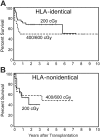Optimization of conditioning for marrow transplantation from unrelated donors for patients with aplastic anemia after failure of immunosuppressive therapy
- PMID: 16684959
- PMCID: PMC1895515
- DOI: 10.1182/blood-2006-03-005041
Optimization of conditioning for marrow transplantation from unrelated donors for patients with aplastic anemia after failure of immunosuppressive therapy
Abstract
In 87 patients with aplastic anemia who failed to respond to immunosuppressive treatment, we determined the minimal dose of total body irradiation (TBI) required when added to antithymocyte globulin (ATG, 30 mg/kg x 3) plus cyclophosphamide (CY, 50 mg/kg x 4) to achieve engraftment of unrelated donor marrow. TBI was started at 3 x 200 cGy, to be escalated or deescalated in steps of 200 cGy depending on graft failure or toxicity. Patients were aged 1.3 to 53.5 years (median, 18.6 years). The interval from diagnosis to transplantation was 3 to 328 months (median, 14.6 months). Donors were HLA-A, -B, -C, -DR, and -DQ identical for 62 patients, and nonidentical for 1 to 3 HLA loci at the antigen or allele level for 25. The dose-limiting toxicity was diffuse pulmonary injury. The optimum TBI dose was 1 x 200 cGy. Nine patients did not tolerate ATG and were prepared with CY + TBI. Graft failure occurred in 5% of patients. With a median follow-up of 7 years, 38 (61%) of 62 HLA-identical, and 10 (40%) of 25 HLA-nonidentical transplant recipients are surviving. The highest survival rate with HLA-identical transplants was observed at 200 cGy TBI. Thus, low-dose TBI + CY + ATG conditioning resulted in excellent outcome of unrelated transplants in patients with aplastic anemia who had received multiple transfusions.
Figures



References
-
- Storb R, Blume KG, O'Donnell MR, et al. Cyclophosphamide and antithymocyte globulin to condition patients with aplastic anemia for allogeneic marrow transplantations: the experience in four centers. Biol Blood Marrow Transplant. 2001;7: 39-44. - PubMed
-
- Hows JM, Yin JL, Marsh J, et al. Histocompatible unrelated volunteer donors compared with HLA nonidentical family donors in marrow transplantation for aplastic anemia and leukemia. Blood. 1986;68: 1322-1328. - PubMed
-
- Kernan NA, Bartsch G, Ash RC, et al. Analysis of 462 transplantations from unrelated donors facilitated by The National Marrow Donor Program. N Engl J Med. 1993;328: 593-602. - PubMed
-
- Bacigalupo A, Oneto R, Bruno B, et al. Current results of bone marrow transplantation in patients with acquired severe aplastic anemia. Report of the European Group for Blood and Marrow Transplantation. On behalf of the Working Party on Severe Aplastic Anemia of the European Group for Blood and Marrow Transplantation. Acta Haematol. 2000;103: 19-25. - PubMed
-
- Gajewski JL, Chattopadhyay A. Treatment of aplastic anemia with bone marrow transplants from closely matched unrelated donors. In: Champlin RE, Gale RP, eds. New Strategies in Bone Marrow Transplantation. New York, NY: Wiley-Liss; 1991: 101-108.
Publication types
MeSH terms
Substances
Grants and funding
LinkOut - more resources
Full Text Sources
Medical
Research Materials

